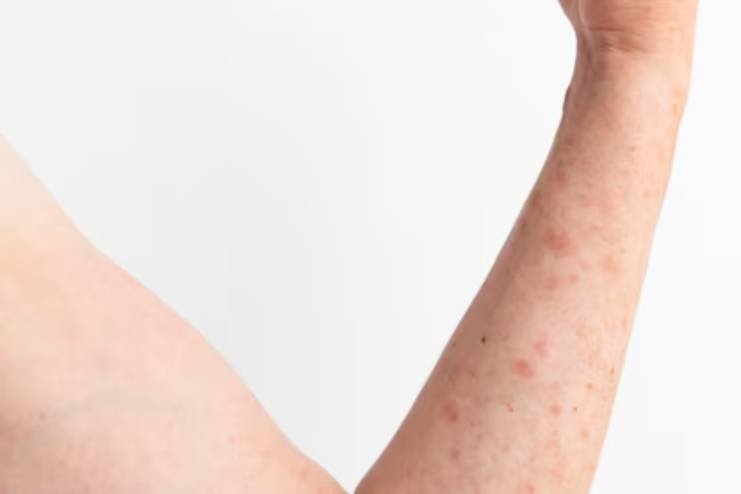Affiliate Disclaimer
Some links in this article are affiliate links. We may earn a small commission if you make a purchase through these links, at no extra cost to you. We only recommend products we find useful to our readersUrticaria, more commonly known as hives, is irritating and affects the quality of life. These welts may vary in size and often merge to form large areas of swelling.
Hives are red, itchy welts formed due to an allergic reaction. These welts can appear suddenly and may last from a few hours to several days. Common symptoms include itching, swelling, and discomfort, which often worsens with scratching.
Various factors, including stress, medications, infections, and food allergies, can trigger hives. Understanding the factors that cause hives and how food allergies are linked to hives is essential.
In this article, we will discuss common food triggers of hives and detail what should be avoided to reduce flare-ups. Identifying and avoiding those dietary triggers may help you manage the symptoms effectively.
Understanding Hives and Food Allergies

Food allergies and hives are related, and allergies play a huge role in triggering hives. Food allergy is a malfunction of the immune system where it mistakes one of the proteins in food as a foreign invader, and the immune system starts to release histamine and other symptom-causing chemicals into the blood. In turn, these immune system chemicals can cause symptoms in various parts of the body, such as hives.
Foods that cause hives include nuts, shellfish, eggs, milk, wheat, etc. Some individuals experience cross-reactivity, leading to hives. Recognizing and avoiding foods that trigger these reactions is essential for managing and preventing hives.
Common Foods That Trigger Hives

Hives, or urticaria, can be triggered by various dietary factors. The trick to managing the symptoms lies in identifying and avoiding the causative factor in food. A few common foods that cause hives are listed below, and the way each of these foods may trigger this reaction is included.
- Shellfish: Well-known allergy-causing foods that can lead to hives include shellfish, such as shrimp, crab, lobster, and other types of fish. Their proteins can induce immune responses, leading to the release of histamines, causing hives.
- Nuts: Tree nuts and peanuts are considered popular food allergens. Proteins in nuts may trigger an allergic reaction in sensitive people; the immune system responds by releasing histamines and other chemicals that result in hives.
- Eggs: Eggs, particularly proteins in egg whites, can trigger urticaria in some individuals. Their immune system mistakes these proteins for foreign substances that will harm them, creating an allergic reaction and, in turn, hives.
- Milk: Milk proteins, such as casein and whey, can cause urticaria in people allergic to milk. When the body’s immune system reacts to these proteins, histamine levels increase and eventually cause those itchy, watery, and raised skin welts.
- Wheat:Wheat allergies are caused by proteins like gluten. These proteins can provoke an immune response with histamine release and the development of hives.
- Soy: A protein in soybean is known to cause allergies in many people. The immune system reacts to this kind of protein by the release of histamine, which causes hives.
- Certain Fruits: Even fruits like strawberries and citrus can form hives in some individuals. The fruits may directly trigger an allergic response or act as histamine releasers.
- Food Additives: Processed foods contain a host of additives, such as preservatives and dyes, known to cause hives. This may be either by direct provocation of allergy or as pseudo allergens when the substances induce an over-response in the immune system to release histamines.
How to Identify Food Triggers

Identifying food triggers is essential in managing hives and other allergic reactions. Listed below are some of the ways through which specific food allergens can be identified:
- Keeping a Food Diary
One of the most effective methods is the food diary, whereby a patient notes down everything that they consume and drink along with the results. It shows a pattern and, in most cases, what triggers hives. To be effective:
- Record the time of consumption and any subsequent symptoms.
- Note down ingredients, portion sizes, and preparation methods.
- Include details about any medications or supplements taken.
- Elimination Diet
In the elimination diet, all suspected allergens are withdrawn from the diet for some period before reintroducing one by one gradually. This helps trace which food may provoke a reaction. Steps involved in the process are:
- Remove all potential triggers from your diet for 2-4 weeks.
- Gradually reintroduce one food at a time, waiting several days before adding another.
- Monitor and record any symptoms that occur during reintroduction.
- Allergy Testing
Food allergy testing can provide specific insights into food allergies. Common methods include:
- Skin Prick Test: A small amount of the suspected allergen is pricked into the skin. If a raised bump appears, it indicates an allergy.
- Blood Test: Measures the presence of specific antibodies (IgE) to certain foods, indicating an allergic response.
Tips for Tracking and Finding Food Triggers
- Consistently record your diet and symptoms to identify patterns.
- Work with an allergist or dietitian for guidance and interpretation of test results.
- Identifying food triggers can take time. Follow the process diligently to obtain accurate results.
Managing and Preventing Hives

One would need an all-around approach to controlling and preventing hives, especially those caused by food allergies. There are plenty of ways to manage food allergies and prevent hives once the triggers are identified.
Steps to Take After Identifying Triggers
- Avoidance Strategies: The most crucial step is to avoid triggers. This involves eliminating specific foods or substances from the diet and environment.
- Reading Food Labels: Carefully read food labels to avoid exposure to allergens. Ingredient lists and allergy warnings should be checked properly.
- Safe Food Alternatives: Identifying and incorporating safe food alternatives can help maintain a balanced diet without triggering hives. For instance, high-histamine foods should be replaced with low-histamine options.
- Importance of Carrying Antihistamines or Epinephrine Auto-Injectors: For severe allergic reactions, carry antihistamines or epinephrine auto-injectors. These medications can provide immediate relief and are critical in emergencies.
Seeking Professional Help

When to See A Doctor for Hives
If hives persist for more than a few days, recur frequently, or are accompanied by severe symptoms like difficulty breathing or swelling of the throat, it’s crucial to see a food allergy specialist or go to the emergency room. Chronic or severe hives indicate an underlying health issue that requires professional treatment.
Role of Allergists and Dietitians
Allergists: Allergists specialize in diagnosing and managing food allergies. They can perform comprehensive allergy tests, such as skin prick or blood tests, to identify specific triggers. Based on the results, they provide detailed guidance on avoiding allergens and managing reactions.
Dietitians: Dietitians play a crucial role in managing food allergies by helping create balanced, allergen-free meal plans. They ensure that one maintains a nutritious diet while avoiding trigger foods. Dietitians can also guide safe food alternatives and help manage dietary restrictions.
Importance of Personalized Treatment Plans
Food allergies should be managed under professional guidance and hives should be prevented. Consultation by allergists and dietitians will be required for diagnosis, treatment, and, most importantly, dietary safety. Personalized treatment plans enable patients to monitor allergies while maintaining general health and well-being.
Conclusion
Identification and management of food triggers are essential in the prevention and treatment of hives. Common food triggers include shellfish, nuts, eggs, milk, wheat, soy, some fruits, and food additives. Keeping a food diary, following an elimination diet, and undertaking allergy testing may help find trigger foods.
Once identified, implementing avoidance strategies, reading food labels carefully, and opting for safe food alternatives are essential. Carrying antihistamines or even epinephrine auto-injectors is important.
In this Article





















